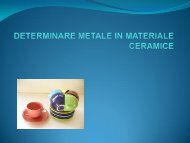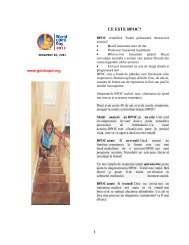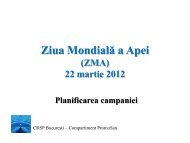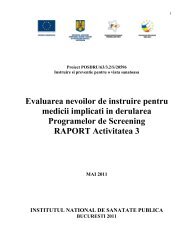Raport PN II 2010 cu date pe 2009 - Institutul National de Sanatate ...
Raport PN II 2010 cu date pe 2009 - Institutul National de Sanatate ...
Raport PN II 2010 cu date pe 2009 - Institutul National de Sanatate ...
Create successful ePaper yourself
Turn your PDF publications into a flip-book with our unique Google optimized e-Paper software.
REZULTATE ŞI DISCUŢ<strong>II</strong><br />
Indicator pozitiv al starii <strong>de</strong> sanatate, <strong>de</strong>zvoltarea fizica a copiilor si adolescentilor reflecta<br />
fi<strong>de</strong>l parti<strong>cu</strong>laritatile socio-economice ale zonei geografice analizate.<br />
Din <strong>date</strong>le prezente reiese ca 71,6%in urban si 69,4%in rural dintre copiii si adolescentii<br />
examinati prezinta o <strong>de</strong>zvoltare fizica armonica, iar restul o <strong>de</strong>zvoltare fizica dizarmonica.<br />
Dezvoltarea dizarmonică <strong>cu</strong> plus <strong>de</strong> greutate are nivele uşor mai mari <strong>de</strong>cât cea <strong>cu</strong> minus <strong>de</strong><br />
greutate. In urban I,<strong>II</strong>,<strong>II</strong>I există tendinţa <strong>de</strong> scă<strong>de</strong>re a <strong>de</strong>zvoltării armonice <strong>cu</strong> vârsta , încât în<br />
urbanul <strong>II</strong>I, la 18 ani doar uşor <strong>pe</strong>ste jumătate din subiecţii examinaţi sunt armonic <strong>de</strong>zvoltaţi.<br />
Doar în rural asistăm la o tendinţă <strong>de</strong> creştere <strong>cu</strong> vârsta a frecvenţei <strong>de</strong>zvoltării armonice, <strong>cu</strong><br />
cele mai mari nivele la 10 şi 15 ani.<br />
Pentru întreg lotul examinat , tendinţa este <strong>de</strong> uşoară scă<strong>de</strong>re.<br />
Pe sexe , frecvenţa <strong>de</strong>zvoltării armonice este mai mare la băieţi faţă <strong>de</strong> fete : M = 70,6%;F =<br />
68,3%.<br />
Pe tipuri <strong>de</strong> indcatori , se schiţează o distribuţie gaussiană a acestora , <strong>cu</strong> cea mai mare<br />
proporţie a indicatorilor mijlocii. Niveluri mai mari ale indicatorilor în etapa <strong>2009</strong> faţă <strong>de</strong> 1999.<br />
Acest as<strong>pe</strong>ct – dovadă a acceleraţiei – este mai evi<strong>de</strong>nt în urban I şi <strong>II</strong> <strong>pe</strong>ntru grupa <strong>de</strong> vărstă 15-<br />
36 luni, şi mai ales <strong>pe</strong>ntru băieţi.<br />
102








